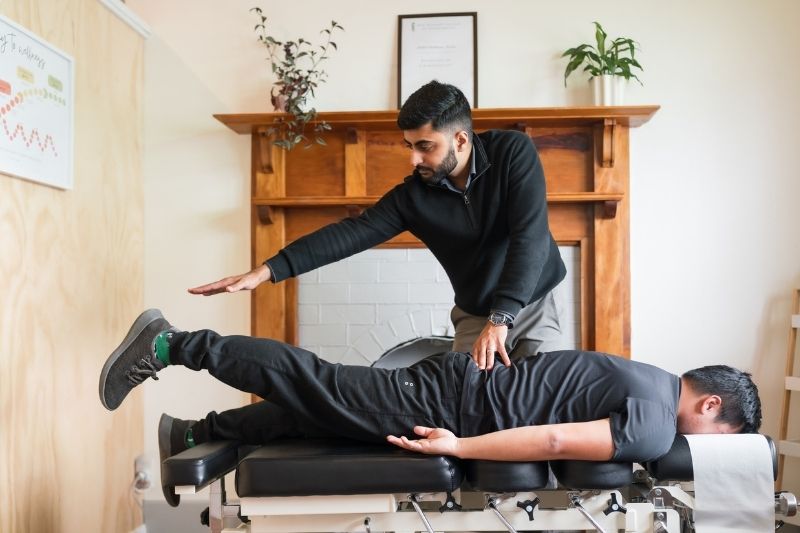If you suffer from a sore back or a stiff neck, you’re not alone. In 2023, the CDC National Center for Health Statistics reported that 24.3% of US adults suffered from chronic pain. Whether it’s in the neck, shoulders, lower back, or elsewhere in the body, chronic pain can severely limit your life or work activities and cause great discomfort. However, regular visits to a chiropractor may help bring relief.
What is chiropractic care?
A complementary therapy, chiropractic care involves physical adjustment or alignment of the spine that’s moved slightly out of position. Millions of Americans trust this therapy, and according to the National Center for Complementary and Integrative Health, over 37 million US adults sought chiropractic care in 2022. Of those people, 85.7% used it for pain management, but, as you’ll see, this is not the therapy’s only benefit.
Does this mean that you should assume you need to see a chiropractor if you experience chronic pain or have issues with your muscles or joints?
While chiropractic care helps millions of people in the US and around the world, it’s not suitable for everyone.
One of the most important things you can do if you’re considering this complementary therapy is to understand when you should see a chiropractor, which means understanding the therapy’s benefits and what these therapists do.
What is a chiropractor?
Chiropractors are licensed practitioners who have completed a Doctorate of Chiropractic (DC) degree and have been licensed through the National Board of Chiropractic Examiners (NBCE). These therapists diagnose and treat mechanical disorders of the spine and joints, as well as other bones and muscles.
Generally, they treat patients using holistic, hands-on methods. These typically include manual adjustments, physical supports, water therapy, and heat therapy. They do not perform surgeries or prescribe medications.
What do chiropractors do?
Chiropractors interview patients, obtain detailed health histories, examine patients, perform tests, and develop a diagnosis. Once complete, they develop unique management plans for patients before starting treatment and monitoring their patients’ progress.
The goal is to improve joint motion and function and treat aches, pains, and strains, focusing on the musculoskeletal system (your muscles and bones). This can be done through a range of treatments, including:
- Adjustments: Gently realigning joins for increased range of motion and reduced pain.
- Exercises and stretches: These treatments help to restore and maintain joint mobility and stability.
- Joint bracing or taping: Also known as Kinesio taping, this treatment supports sprained muscles or joints while they heal.
- Soft-tissue therapy: Can relieve spasms, release connective tissue (fascia) tension, and relax tight or stiff muscles.
- Referrals: Chiropractors can refer patients to integrative medicine experts for dietary and nutrition guidance for weight management or reducing inflammation.
Different types of chiropractors
A wide range of specialties are available in the US, including:
- Naturopathic chiropractors: These medical professionals integrate traditional chiropractic care with natural therapies such as acupuncture, dietary advice, and massage.
- Occupational chiropractic: Practitioners of this specialty focus on patients with physically demanding jobs, helping them improve their posture and reduce pain and the risk of injury.
- Pain management chiropractors: These chiropractors use a variety of techniques, such as spinal manipulation, to relieve pain in patients with chronic pain, migraines, or other chronic conditions.
- Prenatal chiropractic: Those who specialize in prenatal chiropractic care use various techniques to ease back pain, improve posture, and lower the risk of complications. These techniques assist with pelvic balance and create more space for the baby to assist in the birth process and postpartum recovery.
- Pediatric chiropractors: These professionals work to reduce pain and the risk of injury, improve sleep, and “address developmental delays” in children.
- Sports chiropractic: Those focusing on sportspeople create tailored plans and use hands-on treatments for pain and injuries in athletes, helping them to recover faster and improve their performance.
What chiropractors treat
No matter their specialty, all chiropractors treat the musculoskeletal system. Some people choose to see them if they have one or more of the following conditions:
- Arthritis
- Frequent headaches
- Joint dysfunction
- Joint pain
- Lower back pain
- Muscle aches
- Neck pain
- Sciatica
- Stiff muscles
- Whiplash
Benefits of chiropractic care
Chiropractic care can offer a range of benefits if it’s the right course of treatment for your condition. Some of the main benefits of this therapy include:
Reduced back pain: Spinal manipulation can reduce back pain, making them an alternative to invasive procedures.
Reduced neck pain: Addressing misalignments, muscle tension, and nerve compression in the cervical spine can reduce neck pain.
Relief from chronic headaches: Chiropractic care can treat migraines, tension headaches, and chronic headaches.
Improved sleep quality: Treatment may reduce pain and improve sleep quality in patients with chronic pain.
When to see a chiropractor
This type of care isn’t suitable for all musculoskeletal conditions or cases of chronic pain, so it’s important to know when to seek help. Reputable chiropractors will explain what they do upfront and make it easy to book a session when any of the following issues present themselves:
- You’re in acute or chronic pain.
- Your body is out of alignment.
- You sit for extended periods.
- You experience tension headaches or migraines regularly.
- You put repeated stress on your body through physical exercise or playing sports.
- You want to enhance your flexibility or mobility.
If you have any of the following conditions, it’s best to avoid this type of therapy:
- A history or increased risk of stroke.
- Fractures that are healing.
- Certain cancers.
- Severe arthritis or osteoporosis.
- Artificial joints.
- Joint instability.
- Bone or joint infections or tumors.
- Certain dislocations.
- Ruptures or tears in soft tissue.
- Increased ADI space.
- An advanced condition such as Ehlers Danlos Syndrome, Down syndrome, or rheumatoid arthritis.
Consider chiropractic care for better holistic health
Using holistic, non-invasive, hands-on treatments and techniques, chiropractors can support the healing of musculoskeletal issues and help relieve chronic pain.
Just be sure to speak to your doctor beforehand, as your condition may not be suitable for this treatment. If your doctor gives you the go-ahead, make sure you choose a reputable healthcare professional who can provide the type of care you need.




